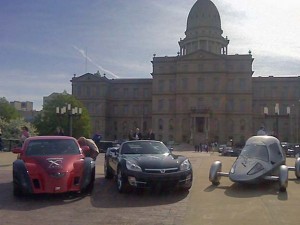
The remaining teams seeking the Progressive Auto X-Prize will go through a shakedown at Michigan International Speedway, in the coming days. Several entrants are seen here at an earlier test.
Roughly two dozen teams have been descending on Michigan International Speedway, or MIS, about 100 miles west of Detroit, this week, and the stakes they’re after are pretty significant – a total of $10 million in cash.
But the Progressive Auto X-Prize isn’t the typical sort of high-speed race. In fact, victory likely won’t go to the fastest car on the track. Modeled after the Orteig Prize that, more than 80 years ago, sent Charles Lindbergh aloft over the Atlantic Ocean for his legendary solo flight, the Auto X-Prize aims to encourage the development of super-clean, ultra-high-mileage automobiles.
But the competition also puts the emphasis on real-world practicality. The winners of the X-Prize, sponsored by Progressive Insurance, will have to demonstrate that their vehicles not only can achieve the equivalent of more than 100 miles per gallon, but that they can be put into production at an affordable cost – all the while meeting both customer expectations and federal regulations.
Revised federal regulations recently began ramping up the Corporate Average Fuel Economy, or CAFE, standard to 35.5 miles per gallon by 2016, a roughly 30% increase, and most industry observers expect Washington to bump the numbers even higher by 2020.
“We’re not only hoping to accelerate the pace of change but also serve as a broker of information to the consumer,” says Eric Cahill, the Auto X-Prize executive director.
The competition was first announced two years ago, at the New York Auto Show, founder Peter Diamandis noting that, “The Model T got 25 miles per gallon and we think, 100 years later, we should be getting over 100 mpg.”
By the time registration closed, in February 2009, 111 teams signed up, and the vehicles they planned to enter fell into three categories. There are relatively conventional vehicles, using a host of technologies to boost the efficiency of conventional gasoline powertrains, and more radical designs relying on batteries or alternative fuels. Among those, there are two separate groups, those with traditional seating and those with tandem layouts.
Ohio-based AMP’s approach was to take a Saturn Sky roadster and replace its gasoline engine with an electric drive system using lithium-ion batteries. One of the advantages of going the so-called “glider route,” said AMP’s Mike Detkas, was the immediate ability to meet federal crash regulations, and the potential to rapidly put the prototype into production.
California’s Zap went with a more radical design, a 2-seat three-wheeler dubbed Alias, that relies on extensive aerodynamic enhancements and lightweight body materials to maximize mileage.
Both AMP and Zap are among the 20 teams that have survived previous cuts. At MIS, they’ll undergo the next in several final shakedown rounds designed to measure fuel efficiency and determine real world viability. Final results will be announced in Washington, D.C., in September.
“It’s always nice to win,” says Gary Starr, the California firm’s founder and product development chief.
There will, in fact, be three winners, the top design from the mainstream category collecting a $5 million check, while the winners of the two alternative categories will take home $2.5 million each.
That’s by no means nearly enough to put the top picks into production, admits Cahill, who points out it can cost “several hundred million” to launch a conventional automobile. But he insists that the winners – and some of the better-conceived runners-up – should get a big boost from the media coverage of the Auto X-Prize, which could spur demand and also help raise some additional cash.
“I’ve got faith in the market,” he insists, though he admits it needs a nudge now and then, which the Progressive Auto X-Prize is designed to provide.
